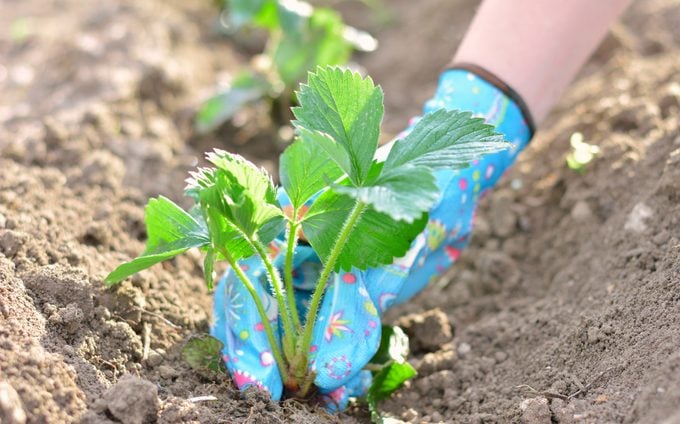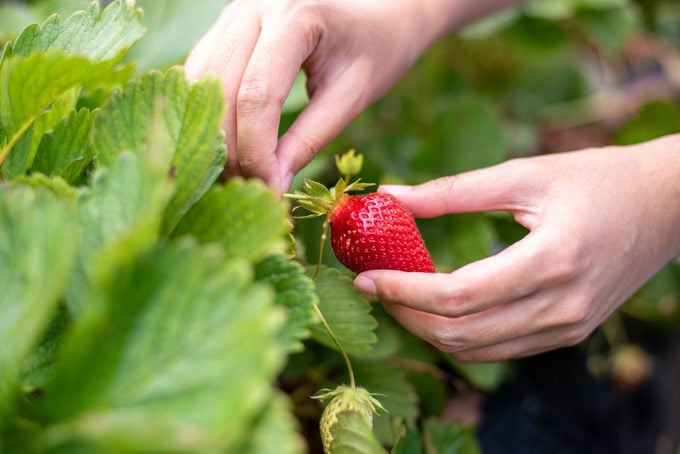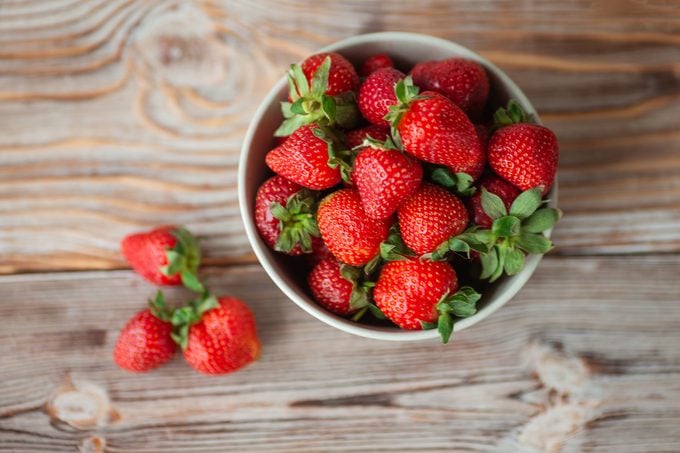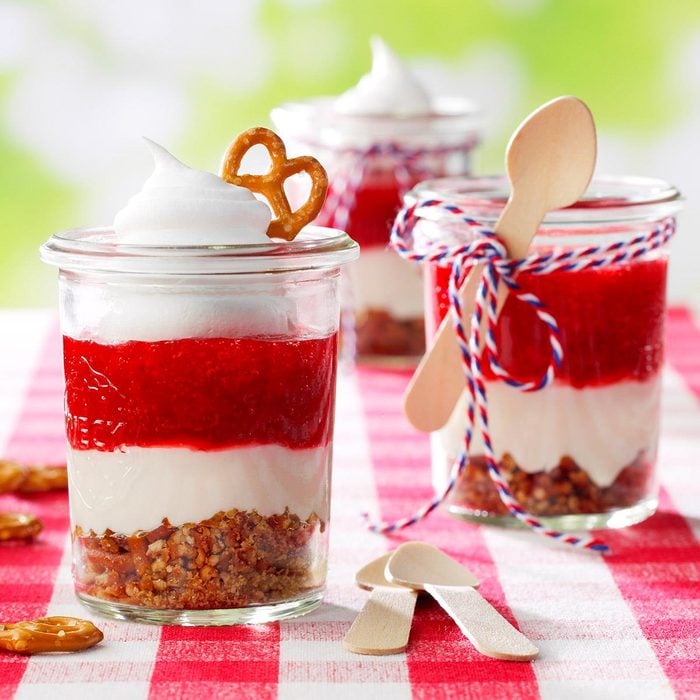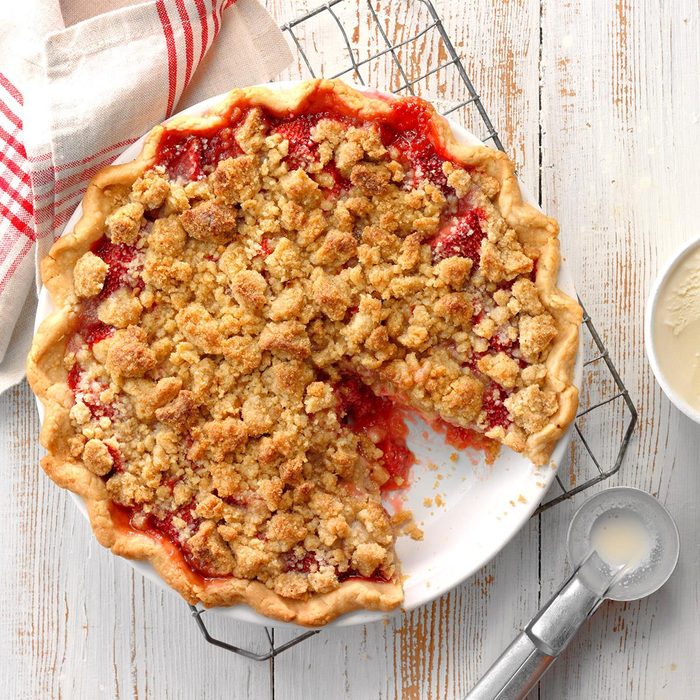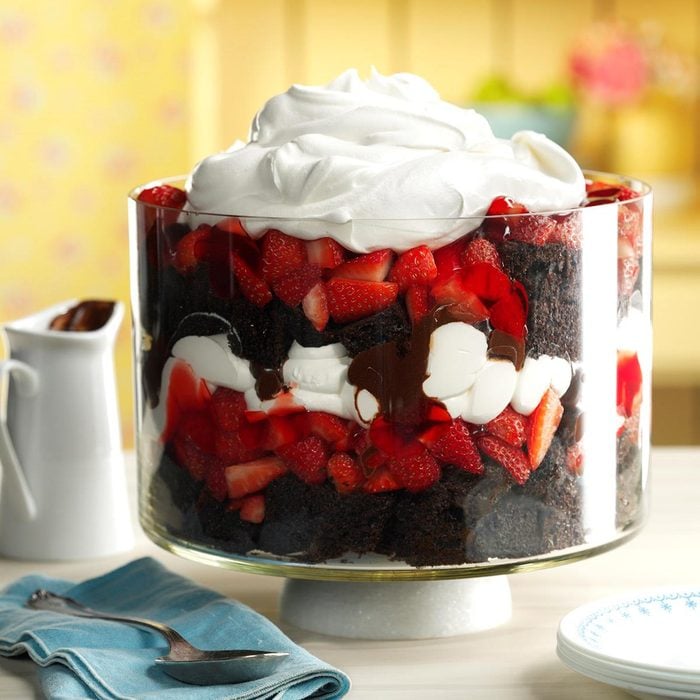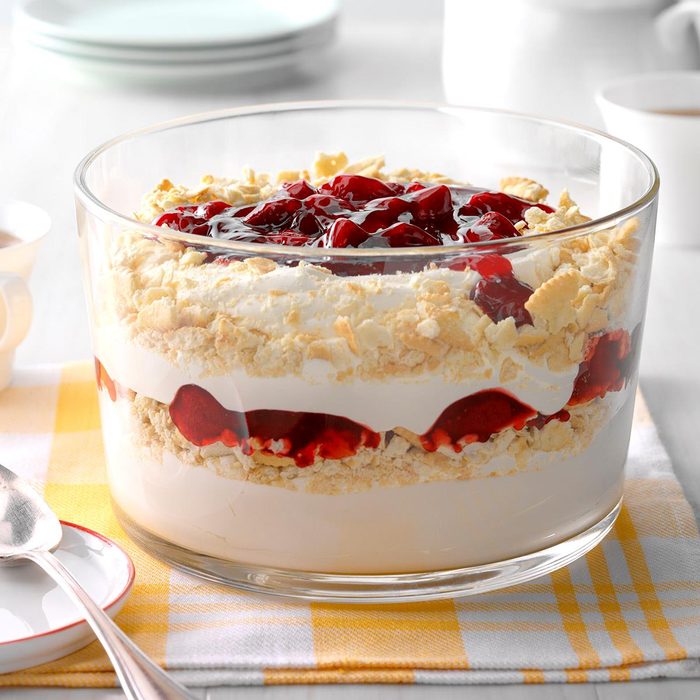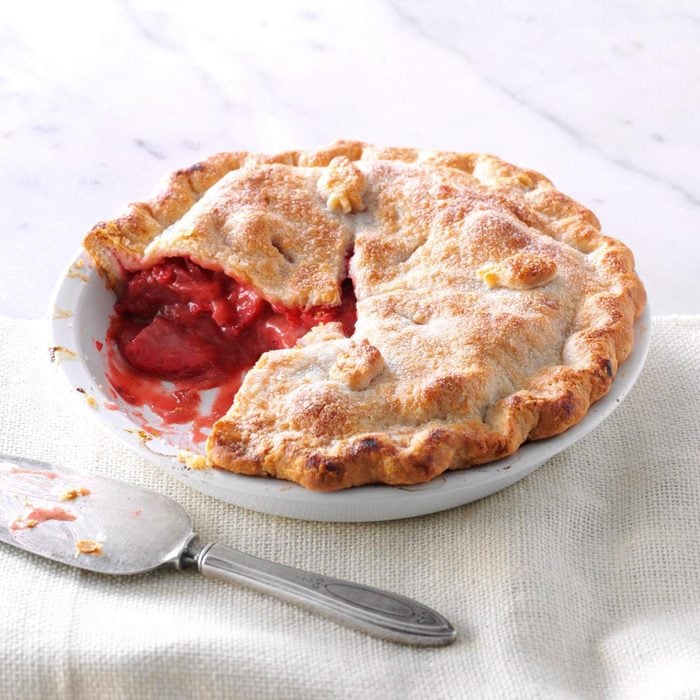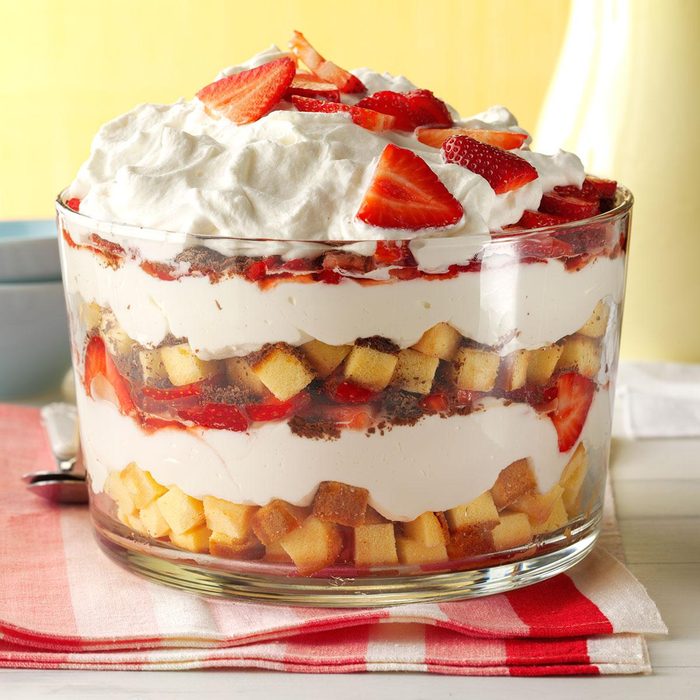Strawberry CheesecakeOur strawberry cheesecake is a dressed-up classic cheesecake with a glossy strawberry glaze and fresh berries.
Chocolate Cupcakes with Strawberry FillingMy husband and I got engaged on Valentine’s Day, so the holiday is extra special in our house. Each year we go all out with fancy desserts. —Kristin Bowers, Gilbert, Arizona
Strawberry PizzaThis strawberry pizza is the perfect treat to end a spring or summer meal.
Strawberry Banana PuddingA slice of this chilled strawberry banana pudding that’s layered with crunchy graham crackers is heavenly on a hot summer’s day.
Chocolate-Covered-Strawberry ShortbreadI wanted to create a cookie that embraced chocolate-covered strawberries, so I started riffing on shortbread. It took a few tries, but I nailed it with this version! Freeze-dried strawberries lend big berry flavor without making the cookies soggy. Be sure to use good-quality chocolate too. —Jennifer Nystrom, Pooler, Georgia
Strawberry MacaronsThese strawberry macarons have a sweet surprise in the filling: strawberry jam. To keep the jam contained, pipe the frosting around the outer edge before adding the jam in the center. —Josh Rink, Milwaukee, Wisconsin
Angel Strawberry DessertThis angel dessert is a wonderful treat when fresh strawberries are readily available. Every time I make this pretty strawberry angel food cake, someone asks for the recipe. —Theresa Mathis, Tucker, Georgia
Strawberry Glaze PieThis strawberry glaze pie was a family favorite while I was growing up and it's the same with my own family, which is nearly all grown. We still go to the strawberry farms to pick our own berries for this pie, and a delicious one it is! —Colleen DeMuth, Le Mars, Iowa
Strawberry SorbetThis three-ingredient strawberry sorbet is quick, easy and incredibly flavorful. Use in-season berries to make this refreshing dessert.
Chocolate-Covered StrawberriesWe are all about chocolate! Follow our simple guide to make decadent chocolate-covered strawberries at home.
Strawberry CakeLooking for the perfect strawberry cake recipe? We use fresh strawberries and strawberry jam to create a cake that is full of juicy berry flavor and looks totally pretty in pink.
Fritters with Lemon Mousse and StrawberriesDeep-fried fritters are wonderful on their own, but they become over-the-top amazing with a creamy lemon mousse and sweet strawberries. Raspberries and blueberries yield equally good results. —Shannon Bell, Woodstock, Georgia
Strawberry Pretzel PieThis cool no-bake strawberry pie is the perfect cure for your sweet tooth, especially in summer. Made with pantry staples, it is as easy as pie to make and has become one of my most requested warm-weather treats. —Shauna Havey, Roy, Utah
Special Stuffed StrawberriesThese sweet bites can be made ahead of time, and they look really colorful on a tray. I will sometimes sprinkle the piped filling with finely chopped pistachio nuts. —Marcia Orlando, Boyertown, Pennsylvania
Strawberry TrifleMaking a strawberry trifle has to be one of the easiest ways to turn simple ingredients into a fancy display of layered sweetness. Here's how to do it, step by step.
Mixed Berry TiramisuBecause I love tiramisu, I came up with this deliciously refreshing twist on the traditional coffee-flavored Italian dessert. Fresh softened berries star with crisp ladyfinger cookies and mascarpone cheese. Serve it from a glass bowl or in clear dishes to show off the luscious layers.
—Najmussahar Ahmed, Ypsilanti, Michigan
Strawberry Lemon TrifleThis refreshingly fruity dessert is one of our favorites. It looks so beautiful layered in a glass bowl that people will think it took ages to make. The secret is starting with a purchased angel food cake. —Lynn Marie Frucci, Pullman, Washington
Strawberry Pretzel Dessert JarsNeed to bring a dish to pass this weekend? This make-ahead layered dessert, adorable in individual Mason jars, will disappear quickly at any potluck. —Aldene Belch Flint, Michigan
Strawberry Rhubarb Dump CakeIt always seems like my rhubarb goes bad in a hurry, so I was looking for a simple way to combine two of my favorite flavors in an incredibly easy dessert. I added extra spices to enhance the flavor of this strawberry-rhubarb dump cake for a sweet treat my whole family loved! —Jessica Bridge, Grand Junction, Colorado
Summer Strawberry Shortcake SoupWhen folks are longing for something sweet and refreshing, this soup is sure to hit the spot. To serve it with dinner or as an appetizer, simply omit the shortcake. —Joan Hallford, North Richland Hills, Texas
Air-Fryer Caribbean WontonsI first served these fresh and fruity air-fryer wontons as an appetizer at a summer luau. My family and friends now enjoy this fried wonton recipe for dessert at special occasions throughout the year. —Melissa Birdsong, Gilbert, South Carolina
Biscuit Strawberry ShortcakeThis biscuit strawberry shortcake is the perfect ending to any meal. Homemade biscuits and fresh berries shine in this classic dessert. —Stephanie Moon, Boise, Idaho
Pecan Strawberry Rhubarb CobblerChock-full of berries and rhubarb, this pretty cobbler is the perfect finale for a dinner for two. Pecans in the topping and the delicious dessert sauce make it extra special. —Lily Julow, Lawrenceville, Georgia
Contest-Winning Strawberry Pretzel DessertI love the sweet-salty flavor of this pretty, layered dessert. Sliced strawberries and gelatin top a smooth cream cheese filling and crispy pretzel crust. I think it's best when eaten within a day of being made. —Wendy Weaver, Leetonia, Ohio
Strawberry Panzanella SaladAlways a crowd-pleaser, this strawberry panzanella salad never disappoints. This version is sweet and offers the opportunity to use seasonal fruits in a creative way. For a fun twist, use margarita glasses when serving and rim the glasses with sugar and a strawberry garnish. —Careema Bell, Trenton, New Jersey
Winnie’s Mini Rhubarb & Strawberry PiesEvery spring, we had strawberries and rhubarb on our farm outside Seattle. These fruity hand pies remind me of those times and of Grandma Winnie’s baking. —Shawn Carleton, San Diego, California
Strawberry Rhubarb Cake with OrangeI came up with this strawberry rhubarb cake when I wanted to make something with rhubarb and strawberries that wasn't a pie. If you know someone who hasn't tried rhubarb before, this is a great way to introduce them to it. —Theresa Kreyche, Tustin, California
Strawberry PieOur strawberry pie celebrates the harvest with a beautiful display of sliced fresh berries in a bouncy, sweet filling.
Best Strawberry ShortcakeFor a dazzling summer dessert, you can’t beat juicy strawberries and fresh whipped cream over homemade shortcake. My father added even more indulgence to this recipe by buttering the shortcake. This is the best strawberry shortcake recipe. —Shirley Joan Helfenbein, Lapeer, Michigan.
Strawberry Lemon CupcakesMy granddaughter Sydney has acquired a love of baking. While I was visiting her in Tampa, we made these light, fluffy cupcakes. She's a natural—they turned out fantastic! —Lonnie Hartstack, Clarinda, Iowa
Strawberry Rhubarb Cheesecake BarsThese cheesecake bars layer a buttery pecan shortbread crust with a rich and creamy filling and sweet-tart strawberry rhubarb jam. For larger squares, cut into nine bars instead of 16. —Amanda Scarlati, Sandy, Utah
Mango CheesecakeThis eggless mango cheesecake is mixed and set in the fridge for an easy, refreshing dessert in the summertime. No oven necessary!
Strawberry Rhubarb CreamA friend gave me this recipe a long time ago. It’s rich and creamy yet refreshing. I make this often in early summer when rhubarb is readily available. —Norma DesRoches, Warwick, Rhode Island
Strawberry Biscuit ShortcakeIt seams Mom was always making biscuits. She served them plain for breakfast and dinner, especially when we had stew or baked beans. My favorite was when she served them like this—topped with fresh strawberries and whipped cream! —Elaine Gagnon, Pawtucket, Rhode Island
Coconut Milk Strawberry-Banana PopsThese four-ingredient freezer pops are a delicious way to use up a pint of fresh strawberries. You'll love the hint of tropical flavor, thanks to the coconut milk. —Taste of Home Test Kitchen
Strawberry Crumble PieI host an annual pie-making party before Labor Day. We have a pig roast on our farm, but the pies take center stage at the end of the meal. —Beth Howard, Donnellson, Iowa
Berry-Cream Cookie SnapsMy mom and I made up this recipe by combining two others. These cute cookies are crispy on the outside and light and fluffy inside. You could also bake the cookies flat and serve the filling as a cookie dip if you'd like. —Crystal Briddick, Colfax, Illinois
Strawberry Cheesecake BitesThese strawberry cheesecake bites are quick and easy, a perfect combo of sweet, creamy cheesecake and chocolate-covered strawberries.
Strawberry Citrus IceDaiquiri fans, put away your straws for this blend of strawberries, lime juice and orange juice in a refreshing ice. — Robin M. Keane, Framingham, Massachusetts
Strawberry Rhubarb Coffee CakeAlthough my coffee cake makes a large pan, it never lasts very long! It's great for a Sunday brunch after church and nice to bring to family reunions, too. —Dorothy Morehouse, Massena, New York
Strawberry Upside-Down CakeFor a tasty twist, this special shortcake has a berry layer on the bottom. The tempting strawberry upside-down cake is a sweet that our family has savored for years. —Debra Falkiner, St. Charles, Missouri
Creamy Strawberry CrepesCreamy strawberry crepes are stuffed with a citrusy, fruity cream cheese filling and garnished with fresh berries. It's enough to make you say "ooh-la-la!"
Roasted Strawberry Sheet CakeMy Grandma Gigi loved summer berry cakes. Almost any time I’d call her during the warmer months, she’d invite me over to taste her latest masterpiece. This cake is a tribute to her. —Kristin Bowers, Rancho Palos Verdes, California
Strawberry Cupcakes with Whipped Cream FrostingFresh strawberries are full of water, so they have a tendency to weigh down cake batters and make soggy cakes. That’s why these strawberry cupcakes rely on strawberry jam or preserves. The concentrated flavor is just right for light and tender cupcakes. —Lisa Kaminski, Wauwatosa, Wisconsin
Chocolate-Covered Strawberry CobblerThis cobbler came about because I love chocolate-covered strawberries. Top it with whipped cream, either plain or with a little chocolate syrup stirred in. —Andrea Bolden, Unionville, Tennessee
Lemon Strawberry ShortcakeEnjoy the signature tastes of summer with this bright and sweet lemon strawberry shortcake, heaped with fresh berries and whipped cream.
Strawberry Cheesecake Ice CreamStrawberry cheesecake ice cream is the perfect summer treat. Pureed strawberries, cream cheese, two types of cream, and graham cracker crumbs give this recipe its fresh flavor and rich texture.
Strawberry Mascarpone CakeDon't let the number of steps in this recipe fool you —it's easy to assemble. The cake bakes up high and fluffy, and the berries add a fresh fruity flavor. Cream cheese is a good substitute if you don't have mascarpone cheese handy. —Carol Witczak, Tinley Park, Illinois
Grilled Angel Food Cake with StrawberriesOne night I goofed, accidentally using the balsamic butter I save for grilling chicken on my pound cake. What a delicious mistake that my entire family loved! For a patriotic look, add a drizzle of blueberry syrup. —Tammy Hathaway, Freeman Twp, Maine
Mamaw Emily's Strawberry CakeMy husband loved his mamaw's strawberry cake recipe. He thought no one could duplicate it. I made it, and it’s just as scrumptious as he remembers. —Jennifer Bruce, Manitou, Kentucky
Lemon-Berry ShortcakeThis simple lemon shortcake is tender and not overly sweet. Enjoy this summertime classic with a generous layer of whipped topping and berries. —Meryl Herr, Overland Park, Kansas
Strawberry TartShowcase those farm-fresh, red-to-the-core summer berries with this outstanding strawberry tart.
Berry Pinwheel CakePerfect for special meals, this lovely chiffon cake is a nice change from strawberry pie or shortcake. Don't be afraid t try this jelly-roll-style dessert...it's easy to make. Plus, the waxed paper-lined pan helps make cleanup a breeze! —Becky Ruff, McGregor, Iowa
Easy Strawberry Lemonade Freezer PieThree simple ingredients mixed together and spread into a graham cracker crust make magic while your freezer does all the work. Prep this pie ahead and freeze it overnight or even longer. Feel free to vary the fruit if you'd like! —Debbie Glasscock, Conway, Arkansas
Nutella-Stuffed StrawberriesGourmet strawberries are pricey to order but easy to make. We serve strawberries with hazelnut spread as a crowd-pleasing appetizer or dessert. —Darlene Brenden, Salem, Oregon
Strawberry Ice Cream CakeWe turned an iconic ice cream truck treat into a dessert you can make at home. Learn how to make a strawberry crunch ice cream cake.
Chocolate Strawberry Punch Bowl TrifleI threw this dessert together when I needed something quick to take to my in-laws’. Because it’s beautiful, everyone thinks it requires a lot of effort. It’s easy. And the recipe makes a lot, making this perfect for potlucks and large gatherings. —Kristi Judkins, Morrison, Tennessee
Strawberry-Chocolate Meringue TorteI make this rich and delicious torte whenever I'm asked to bring dessert to any occasion. Use reduced-calorie whipped topping to create a lighter version. —Christine McCullough, Auburn, Massachusetts
Strawberry-Hazelnut Meringue ShortcakesIn summer the strawberry farms are open for picking. I serve strawberries with a crunchy hazelnut meringue cookie. —Barbara Estabrook, Rhinelander, Wisconsin
Freezer Strawberry Shortbread DessertWhen I’m planning party menus, I appreciate dessert recipes like this; you can make and freeze it up to two weeks before serving. A refreshing slice is welcome after a big meal.—Cassie Alexander, Muncie, Indiana
Cornmeal Towers with Strawberries & CreamMy kids love to help make these towers. They measure, mix, whisk and build stacks. It's a family custom and a perfect summer breakfast or dessert. —Josie Shapiro, San Francisco, California
Strawberry-Lime BarsOur family loves fresh strawberries, so I look for different ways to use them. This tempting, yummy dessert has sweet strawberries, tart lime and salty pretzels. —Alexandra Barnett, Forest, Virginia
Strawberry Ladyfinger Icebox CakeThis cake is inventive and yet familiar. Be sure to use a springform pan so you can easily remove it from the cake. If it breaks while you're transferring it to the serving plate, just push the pieces back together, pressing gently. —Stella Ohanian, Porter Ranch, California
Chocolate Lover's Strawberry ShortcakesAs a mom of four, I appreciate shortcut recipes. This one uses refrigerated biscuits, giving me time for special touches, like adding homemade whipped cream and hot fudge. —Melissa Haines, Valparaiso, Indiana
Strawberries & Cream TorteThis festive strawberries and cream summer treat is one of my mom's favorites. It wows guests every time yet is simple to make. —Cathy Branciaroli, Wilmington, Delaware
Slow-Cooker Strawberry Pudding CakeI had these ingredients in my pantry and thought I'd experiment. The flavors are just like strawberry cheesecake—only in a warm, comforting cake version. It's a whole lot easier than making cheesecake, too! —Lisa Renshaw, Kansas City, Missouri
Cheesecake-Stuffed StrawberriesCheesecake-stuffed strawberries are simple to make and packed full of flavor. They're sure to be a hit at your next party.
Strawberry Shortcake PuffsAn easy and delicious recipe for strawberry shortcake puffs made with store-bought puff pastry dough, whipped cream and fresh strawberries.
Cheesecake Strawberry TrifleThe only drawback to this lovely dessert is that there are never any leftovers. For a patriotic look, replace one of the layers of strawberry pie filling with blueberry—or use whatever filling you prefer. —Lori Thorp, Frazee, Minnesota
Chocolate-Dipped Strawberry Meringue RosesEat these pretty treats as is or crush them into a bowl of strawberries and whipped cream. Readers of my blog, utry.it, went nuts when I posted that idea.—Amy Tong, Anaheim, California
Strawberry BlissYou'll love this homemade puff pastry crust topped with a soft-set pudding layer that has a hint of strawberry flavor. This dessert needs to chill for at least an hour, so it's a fabulous make-ahead dish. —Candace Richter, Stevens Point, Wisconsin
Strawberry Ice Cream CharlotteMy family loves ice cream cake, so they were delighted when I first presented this dessert. It's light, delicious and has a festive presentation. —Scarlett Elrod, Newman, Georgia
Double-Crust Strawberry PieThe first time I made this pie it was delectable, so I wanted to share it. Fresh strawberries sprinkled with cinnamon make a delicious pie served warm or slightly chilled. —Patricia Kutchins, Lake Zurich, Illinois
Strawberry GelatoOur contest-winning strawberry gelato is an easy and luscious summer dessert, and a perfect way to use ripe berries!
Strawberry Shortcake CookiesIf you like strawberry shortcake, these strawberry shortcake cookies capture that wonderful flavor in cookie form. Ripe berries are blended into a creamy icing and spread over the cookies for a pretty-in-pink finish.
White Chocolate-Strawberry TiramisuOur strawberry tiramisu recipe is a twist on a classic tiramisu, using ladyfingers as the base structure for a delicious dessert with flavors reminiscent of a strawberry cassata cake. Fresh strawberries are the star of this tasty treat that's topped with creamy layers of luscious flavor. Be forewarned; you may want to keep the entire dessert for yourself!
Homemade Strawberry Ice CreamThis creamy, luscious ice cream will remind you of the signature treat served at church ice cream socials. What dessert could be better? —Esther Johnson, Merrill, Wisconsin—Esther Johnson, Merrill, Wisconsin
Strawberry Cheesecake TrifleFor a dessert that looks as great as it tastes, this one can't be beat! Layers of rich pound cake, luscious cream and sweet strawberries make this treat very inviting. —Marnie Stoughton, Glenburnie, Ontario
Cool Strawberry CreamThis fruity, luscious dessert makes a wonderful ending to a special dinner. When fresh strawberries are not available, substitute two packages frozen unsweetened strawberries, thawed and drained, for the fresh. —Joyce Cooper, Mount Forest, Ontario
Fruit TartIt's well worth the effort to whip up this creamy fruit tart bursting with juicy berries. A friend gave me the recipe, and it always receives rave reviews at gatherings. —Susan Terzakis, Andover, Massachusetts

